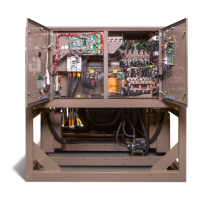JOHNSON CONTROLS
170
SECTION 9 - MAINTENANCE
Form 201.47-ICOM1
Issue date: 17/11/2022
Table 30 - R-513A pressure to saturated temperature conversion
Pressure
psig (bar)
Temperature
average
0
F(
0
C)
Pressure
psig (bar)
Temperature
average
0
F(
0
C)
Pressure
psig (bar)
Temperature
average
0
F(
0
C)
Pressure
psig (bar)
Temperature
average
0
F(
0
C)
0.0 (0.0) -20.5 (-29.1) 130 (8.96) 99.3 (37.4) 260 (17.93) 146.7 (63.8) 390 (26.89) 179.1 (81.7)
5.0 (0.34) -8.4 (-22.4) 135 (9.31) 101.6 (38.7) 265 (18.27) 148.1 (64.5) 395 (27.23) 180.2 (82.3)
10.0 (0.69) 1.4 (-17.0) 140 (9.65) 103.9 (39.9) 270 (18.62) 149.6 (65.3) 400 (27.58) 181.2 (82.9)
15.0 (1.03) 9.8 (-12.3) 145 (10.0) 106.1 (41.2) 275 (18.96) 151.0 (66.1) 405 (27.92) 182.3 (83.5)
20.0 (1.38) 17.2 (-8.2) 150 (10.34) 108.3 (42.4) 280 (19.31) 152.4 (66.9) 410 (28.27) 183.3 (84.1)
25.0 (1.72) 23.8 (-4.5) 155 (10.69) 110.4 (43.5) 285 (19.65) 153.7 (67.6) 415 (28.61) 184.3 (84.6)
30.0 (2.07) 29.8 (-1.2) 160 (11.03) 112.4 (44.7) 290 (19.99) 155.1 (68.4) 420 (28.96) 185.4 (85.2)
35.0 (2.41) 35.3 (1.8) 165 (11.38) 114.5 (45.8) 295 (20.34) 156.4 (69.1) 425 (29.30) 186.4 (85.8)
40.0 (2.76) 40.4 (4.6) 170 (11.72) 116.4 (46.9) 300 (20.68) 157.7 (69.8) 430 (29.65) 187.4 (86.3)
45.0 (3.10) 45.1 (7.3) 175 (12.07) 118.4 (48.0) 305 (21.03) 159.0 (70.6) 435 (29.99) 188.4 (86.9)
50.0 (3.45) 49.5 (9.7) 180 (12.41) 120.3 (49.1) 310 (21.37) 160.3 (71.3) 440 (30.34) 189.4 (87.4)
55.0 (3.79) 53.7 (12.1) 185 (12.76) 122.2 (50.1) 315 (21.72) 161.6 (72.0) 445 (30.68) 190.3 (87.4)
60.0 (4.14) 57.7 (14.2) 190 (13.10) 124.0 (51.1) 320 (22.06) 162.9 (72.7) 450 (31.03) 191.3 (88.5)
65.0 (4.48) 61.5 (16.4) 195 (13.44) 125.8 (52.1) 325 (22.41) 164.1 (73.4) 455 (31.37) 192.2 (89.0)
70.0 (4.83) 65.1 (18.4) 200 (13.79) 127.6 (53.1) 330 (22.75) 165.3 (74.1) 460 (31.72) 193.2 (89.6)
75.0 (5.17) 68.5 (20.3) 205 (14.13) 129.3 (54.1) 335 (23.10) 166.6 (74.8) 465 (32.06) 194.1 (90.1)
80.0 (5.52) 71.9 (21.2) 210 (14.48) 131.0 (55.0) 340 (23.44) 167.8 (75.4) 470 (32.41) 195.1 (90.6)
85.0 (5.86) 75.0 (23.9) 215 (14.82) 132.7 (55.9) 345 (23.79) 168.9 (76.1) 475 (32.75) 196.0 (91.1)
90.0 (6.21) 78.1 (25.6) 220 (15.17) 134.3 (56.8) 350 (24.13) 170.1 (76.7) 480 (33.09) 196.9 (91.6)
95.0 (6.55) 81.0 (27.2) 225 (15.51) 136.0 (57.8) 355 (24.48) 171.3 (77.4) 485 (33.44) 197.8 (92.1)
100.0 (6.89) 83.9 (28.8) 230 (15.86) 137.6 (58.7) 360 (24.82) 172.4 (78.0) 490 (33.78) 198.7 (92.6)
105.0 (7.24) 86.6 (30.3) 235 (16.20) 139.1 (59.5) 365 (25.17) 173.6 (78.7) 495 (34.13) 199.6 (93.1)
110.0 (7.58) 89.3 (31.8) 240 (16.55) 140.7 (60.4) 370 (25.51) 174.7 (79.3) 500 (34.47) 200.4 (93.6)
115.0 (7.93) 91.9 (33.3) 245 (16.89) 142.2 (61.2) 375 (25.86) 175.8 (79.9) 505 (34.82) 201.3 (94.1)
120.0 (8.27) 94.4 (34.7) 250 (17.24) 143.7 (62.1) 380 (26.20) 176.9 (80.5)
125.0 (8.62) 96.9 (36.5) 255 (17.58) 145.2 (62.9) 385 (26.54) 178.0 (81.1)
Before charging, establish the starting weight for the
refrigerant cylinder. When the chiller has been vapor
charged to the appropriate saturation pressure, you
might need to use a refrigerant pump to draw vapor
from the chiller and discharge it to the vapor connec-
tion of the refrigerant cylinder. This helps to create a
pressure differential for pushing the refrigerant liquid
from the cylinder to the chiller.
While charging, take every precaution to prevent air
from entering the system. Create a suitable charging
connection from new copper tubing or correctly select-
ed flexible charging hoses. Fit this charging connection
between the system charging valve and the fitting on
the charging drum.
This connection must be as short as possible but long
enough to provide sufficient flexibility for changing
drums. It must also contain a tee fitting with a valve
that can serve as a connection point to a vacuum pump
to evacuate the charging lines.
The charging connection must be evacuated each time
the lines are disconnected for changing cylinders or
any of the components of the charging process.
The charging line must also contain a sight glass.
When liquid charging is performed, the sight glass can
be monitored to determine when the liquid is no longer
being transferred to the chiller.
The refrigerant charge is specified for each chiller
model on the unit data plate or in the factory order form
(FOF) that is provided for every new sale. Charge the
chiller based on the amount specified in the FOF less
10%. For example, for a chiller that requires 500# of
refrigerant, the initial refrigerant charge is 450#, 500
- 50 = 450. This allows room to trim the charge as out-
lined in Checking and trimming the refrigerant charge
on page 172 .

